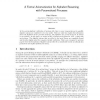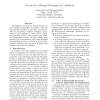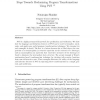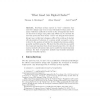FAC
1998
15 years 18 days ago
1998
In the process-algebraic veri cation of systems with three or more components put in parallel, alphabet axioms are considered to be very useful. These are rules that exploit the i...
128
click to vote
TPCD
1994
15 years 2 months ago
1994
Theorem proving techniques are particularly well suited for reasoning about arithmetic above the bit level and for relating di erent f abstraction. In this paper we show how a non-...
103
click to vote
FTCS
1998
15 years 2 months ago
1998
The traditional use of formal methods has been for the veri cation of algorithms or protocols. Given the high cost and limitations in state space coverage provided by conventional...
125
click to vote
REX
1991
15 years 4 months ago
1991
We survey logic-based and automata-based languages and techniques for the speci cation and veri cation of real-time systems. In particular, we discuss three syntactic extensions of...
105
click to vote
MPC
1995
Springer
15 years 4 months ago
1995
Springer
PVS is a highly automated framework for speci cation and veri cation. We show how the language and deduction features of PVS can be used to formalize, mechanize, and apply some us...
135
click to vote
FMCAD
2000
Springer
15 years 4 months ago
2000
Springer
Image computation nds wide application in VLSI CAD, such as state reachability analysis in formal veri cation and synthesis, combinational veri cation, combinational and sequential...
112
click to vote
ICALP
1992
Springer
15 years 5 months ago
1992
Springer
Real-time systems operate in \real," continuous time and state changes may occur at any real-numbered time point. Yet many veri cation methods are based on the assumption that...
110
click to vote
CAV
1992
Springer
15 years 5 months ago
1992
Springer
State-space caching is a veri cation technique for nite-state concurrent systems. It performs an exhaustive exploration of the state space of the system being checked while storin...
118
click to vote
ICALP
1994
Springer
15 years 5 months ago
1994
Springer
When provingthe correctness of algorithmsin distributed systems, one generally considers safety conditions and liveness conditions. The Input Output I O automaton model and its ti...
133
click to vote
LICS
1993
IEEE
15 years 5 months ago
1993
IEEE
We consider the veri cation of a particular class of in nite-state systems, namely systems consisting of nite-state processes that communicate via unbounded lossy FIFO channels. T...




